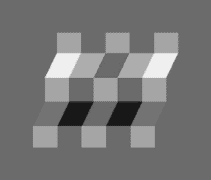Compare the top and bottom gray squares for their brightness. They appear (and, indeed, physically are) equal. Moving the mouse over the image (or tapping it) removes the red bars. Now the squares appear in a different context, and, lo and behold, they do not look equal anymore.

When interpreted as a 3-dimensional scene, our visual system immediately estimates a lighting vector and uses this to judge the property of the material.
The explanation is disputed by Todorovic (1997) [thanks to Mark E. McCourt for the pointer]. However, I do not find his counter example (bottom left) completely convincing. See next illusion for a stronger effect.
Adelson EH (1993) Perceptual organization and the judgment of brightness. Science 262:2042–2044
Demo from Ted Adelson’s site
Todorovic D (1997) Lightness and junctions. Percept 26:379–395